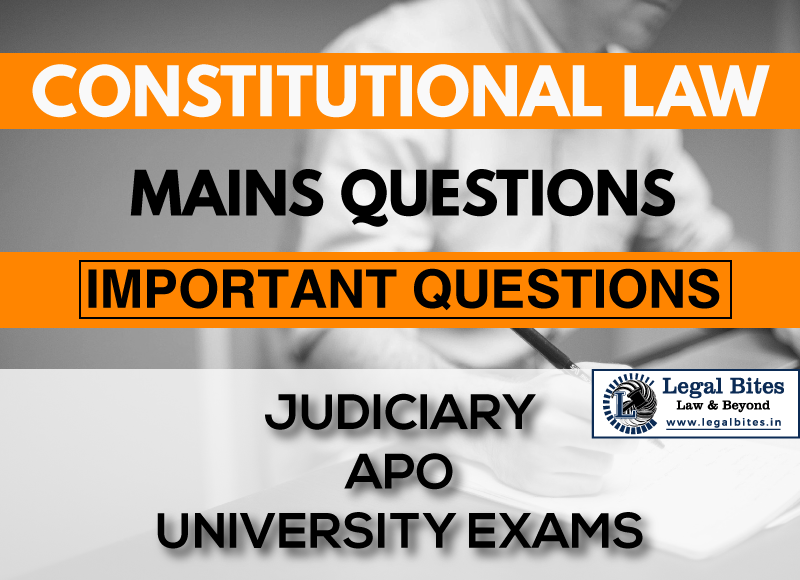Describe the facts and principles of law laid down in Lakshmi Kant Pandey v. Union of India, AIR 1984 SC 469
Question: Describe the facts and principles of law laid down in Lakshmi Kant Pandey v. Union of India, AIR 1984 SC 469 [RJS 1988] Find the answer to the mains question only on Legal Bites. [Describe the facts and principles of law laid down in Lakshmi Kant Pandey v. Union of India, AIR 1984 SC 469.] Answer Facts… Read More »

Question: Describe the facts and principles of law laid down in Lakshmi Kant Pandey v. Union of India, AIR 1984 SC 469 [RJS 1988] Find the answer to the mains question only on Legal Bites. [Describe the facts and principles of law laid down in Lakshmi Kant Pandey v. Union of India, AIR 1984 SC 469.] Answer Facts of the case: Laxmi Kant Pandey was an attorney who through a letter wrote to the Supreme Court regarding neglect and malpractice in the adoption of Indian children to foreign...
Question: Describe the facts and principles of law laid down in Lakshmi Kant Pandey v. Union of India, AIR 1984 SC 469 [RJS 1988]
Find the answer to the mains question only on Legal Bites. [Describe the facts and principles of law laid down in Lakshmi Kant Pandey v. Union of India, AIR 1984 SC 469.]
Answer
Facts of the case: Laxmi Kant Pandey was an attorney who through a letter wrote to the Supreme Court regarding neglect and malpractice in the adoption of Indian children to foreign parents. This was done by social organizations and adoption agencies. He mentioned the long and toxic journey these children made to the countries and the incidences of neglect they had to go through because of their adopted parents, sometimes also resulting in sexual exploitation of the children which was treated as a writ petition.
Apart from the Government of India, several government agencies and social welfare organizations (both national and international) filed affidavits and statements before the court in this case. The Supreme Court explicitly acknowledged their contribution in its judgment stating that the valuable recommendations provided for the consideration of the Court helped the judges formulate the principles and norms to be observed in the case of inter-country adoptions.
Decision and Principle held:
The Court in its judgment set forth safeguards such that adoptions by foreigners would be handled in a manner promoting children’s welfare and their right to family life.
It was brought to attention that there was no regulation of inter-country adoptions in India which might lead to the trafficking of children. For the same purpose, the Court noted that the absence of legal regulation of inter-country adoptions in India could cause enormous harm to Indian children so, in consultation with several social or child welfare institutions, the court laid out a comprehensive framework of normative and procedural safeguards for regulating inter-country adoption as protection against abuse, maltreatment or exploitation of children and to secure them a healthy, decent healthy family life.
The international adoptions would follow the regulations of the Guardians and Wards Act, 1890. Provisions like Articles 15 (3), 24, and 39 of the Indian constitution were used as a reference along with the UN declaration of 1959 on the rights of the child.
It was made compulsory that foreigners who wish to adopt Indian children should be sponsored by licensed agencies of their own country. No adoption application from a foreigner should be entertained directly by any adoption agency in India, that agencies working on inter-country adoptions and licensed by the Government of India must meet certain stipulated criteria and undertake specific responsibilities in ensuring the safety and well-being of adopted children, and that all inter-country adoption proceedings must be approved by the local courts.
There was a supplement judgment on 27th September 1985 due to certain difficulties in implementation of the principles laid down. The Supreme Court held that in case of violation of the principles the adoption would be declared as invalid and the concerned person would have to face strict action.
Important Mains Questions Series for Judiciary, APO & University Exams
- Constitutional Law Mains Questions Series Part-I
- Constitutional Law Mains Questions Series Part-I
- Constitutional Law Mains Questions Series Part-II
- Constitutional Law Mains Questions Series Part-IV
- Constitutional Law Mains Questions Series Part-V
- Constitutional Law Mains Questions Series Part-VI
- Constitutional Law Mains Questions Series Part-VII
- Constitutional Law Mains Questions Series Part-VIII
- Constitutional Law Mains Questions Series Part-IX
- Constitutional Law Mains Questions Series Part-X
Admin Legal Bites
Legal Bites Study Materials correspond to what is taught in law schools and what is tested in competitive exams. It pledges to offer a competitive advantage, prepare for tests, and save a lot of money.
